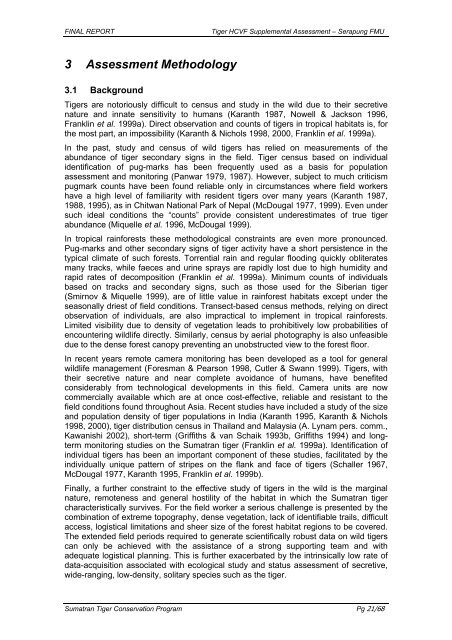A Supplemental HCVF Assessment on the Sumatran Tiger ...
A Supplemental HCVF Assessment on the Sumatran Tiger ...
A Supplemental HCVF Assessment on the Sumatran Tiger ...
You also want an ePaper? Increase the reach of your titles
YUMPU automatically turns print PDFs into web optimized ePapers that Google loves.
FINAL REPORT <strong>Tiger</strong> <str<strong>on</strong>g>HCVF</str<strong>on</strong>g> <str<strong>on</strong>g>Supplemental</str<strong>on</strong>g> <str<strong>on</strong>g>Assessment</str<strong>on</strong>g> – Serapung FMU<br />
3 <str<strong>on</strong>g>Assessment</str<strong>on</strong>g> Methodology<br />
3.1 Background<br />
<strong>Tiger</strong>s are notoriously difficult to census and study in <strong>the</strong> wild due to <strong>the</strong>ir secretive<br />
nature and innate sensitivity to humans (Karanth 1987, Nowell & Jacks<strong>on</strong> 1996,<br />
Franklin et al. 1999a). Direct observati<strong>on</strong> and counts of tigers in tropical habitats is, for<br />
<strong>the</strong> most part, an impossibility (Karanth & Nichols 1998, 2000, Franklin et al. 1999a).<br />
In <strong>the</strong> past, study and census of wild tigers has relied <strong>on</strong> measurements of <strong>the</strong><br />
abundance of tiger sec<strong>on</strong>dary signs in <strong>the</strong> field. <strong>Tiger</strong> census based <strong>on</strong> individual<br />
identificati<strong>on</strong> of pug-marks has been frequently used as a basis for populati<strong>on</strong><br />
assessment and m<strong>on</strong>itoring (Panwar 1979, 1987). However, subject to much criticism<br />
pugmark counts have been found reliable <strong>on</strong>ly in circumstances where field workers<br />
have a high level of familiarity with resident tigers over many years (Karanth 1987,<br />
1988, 1995), as in Chitwan Nati<strong>on</strong>al Park of Nepal (McDougal 1977, 1999). Even under<br />
such ideal c<strong>on</strong>diti<strong>on</strong>s <strong>the</strong> “counts” provide c<strong>on</strong>sistent underestimates of true tiger<br />
abundance (Miquelle et al. 1996, McDougal 1999).<br />
In tropical rainforests <strong>the</strong>se methodological c<strong>on</strong>straints are even more pr<strong>on</strong>ounced.<br />
Pug-marks and o<strong>the</strong>r sec<strong>on</strong>dary signs of tiger activity have a short persistence in <strong>the</strong><br />
typical climate of such forests. Torrential rain and regular flooding quickly obliterates<br />
many tracks, while faeces and urine sprays are rapidly lost due to high humidity and<br />
rapid rates of decompositi<strong>on</strong> (Franklin et al. 1999a). Minimum counts of individuals<br />
based <strong>on</strong> tracks and sec<strong>on</strong>dary signs, such as those used for <strong>the</strong> Siberian tiger<br />
(Smirnov & Miquelle 1999), are of little value in rainforest habitats except under <strong>the</strong><br />
seas<strong>on</strong>ally driest of field c<strong>on</strong>diti<strong>on</strong>s. Transect-based census methods, relying <strong>on</strong> direct<br />
observati<strong>on</strong> of individuals, are also impractical to implement in tropical rainforests.<br />
Limited visibility due to density of vegetati<strong>on</strong> leads to prohibitively low probabilities of<br />
encountering wildlife directly. Similarly, census by aerial photography is also unfeasible<br />
due to <strong>the</strong> dense forest canopy preventing an unobstructed view to <strong>the</strong> forest floor.<br />
In recent years remote camera m<strong>on</strong>itoring has been developed as a tool for general<br />
wildlife management (Foresman & Pears<strong>on</strong> 1998, Cutler & Swann 1999). <strong>Tiger</strong>s, with<br />
<strong>the</strong>ir secretive nature and near complete avoidance of humans, have benefited<br />
c<strong>on</strong>siderably from technological developments in this field. Camera units are now<br />
commercially available which are at <strong>on</strong>ce cost-effective, reliable and resistant to <strong>the</strong><br />
field c<strong>on</strong>diti<strong>on</strong>s found throughout Asia. Recent studies have included a study of <strong>the</strong> size<br />
and populati<strong>on</strong> density of tiger populati<strong>on</strong>s in India (Karanth 1995, Karanth & Nichols<br />
1998, 2000), tiger distributi<strong>on</strong> census in Thailand and Malaysia (A. Lynam pers. comm.,<br />
Kawanishi 2002), short-term (Griffiths & van Schaik 1993b, Griffiths 1994) and l<strong>on</strong>gterm<br />
m<strong>on</strong>itoring studies <strong>on</strong> <strong>the</strong> <strong>Sumatran</strong> tiger (Franklin et al. 1999a). Identificati<strong>on</strong> of<br />
individual tigers has been an important comp<strong>on</strong>ent of <strong>the</strong>se studies, facilitated by <strong>the</strong><br />
individually unique pattern of stripes <strong>on</strong> <strong>the</strong> flank and face of tigers (Schaller 1967,<br />
McDougal 1977, Karanth 1995, Franklin et al. 1999b).<br />
Finally, a fur<strong>the</strong>r c<strong>on</strong>straint to <strong>the</strong> effective study of tigers in <strong>the</strong> wild is <strong>the</strong> marginal<br />
nature, remoteness and general hostility of <strong>the</strong> habitat in which <strong>the</strong> <strong>Sumatran</strong> tiger<br />
characteristically survives. For <strong>the</strong> field worker a serious challenge is presented by <strong>the</strong><br />
combinati<strong>on</strong> of extreme topography, dense vegetati<strong>on</strong>, lack of identifiable trails, difficult<br />
access, logistical limitati<strong>on</strong>s and sheer size of <strong>the</strong> forest habitat regi<strong>on</strong>s to be covered.<br />
The extended field periods required to generate scientifically robust data <strong>on</strong> wild tigers<br />
can <strong>on</strong>ly be achieved with <strong>the</strong> assistance of a str<strong>on</strong>g supporting team and with<br />
adequate logistical planning. This is fur<strong>the</strong>r exacerbated by <strong>the</strong> intrinsically low rate of<br />
data-acquisiti<strong>on</strong> associated with ecological study and status assessment of secretive,<br />
wide-ranging, low-density, solitary species such as <strong>the</strong> tiger.<br />
<strong>Sumatran</strong> <strong>Tiger</strong> C<strong>on</strong>servati<strong>on</strong> Program Pg 21/68

















